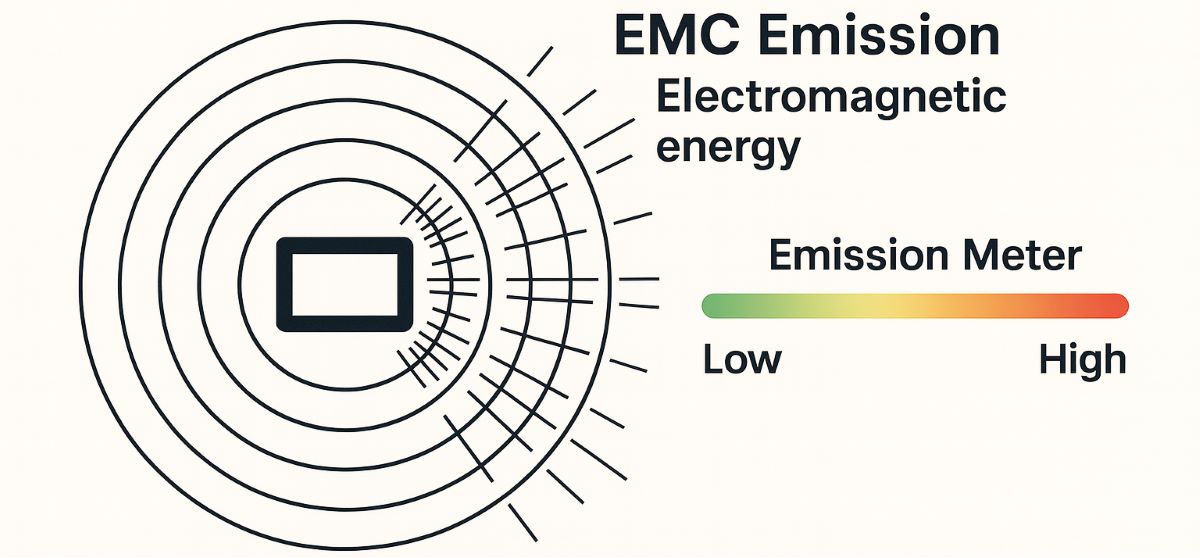What is EMC emission?

EMC stands for "electromagnetic compatibility". EMC emission refers to the amount of electromagnetic energy that is emitted by a device or system, such as a computer or a piece of electronic equipment. This energy can interfere with the operation of other electronic devices, and EMC emissions are regulated to ensure that they do not cause harm to other equipment or cause interference.
What Is EMC Emission? – Interactive Teaching Simulation
Tweak the controls below; the wave field, estimated emission level, and simple spectrum view update instantly.
Radiation Field Visualization
The centered box is the source. Rings and ray density depict the spread of the electromagnetic field in space.
Simple Spectrum View
Peaks: fundamental and harmonicsVertical bars show estimated spectral components. As mitigation increases, bars drop.
Source & Design Factors
Mitigation
Tip: As dv/dt and cable length increase, radiation grows. Shielding, filtering, and good grounding reduce radiated emission.
EMC emission is the electromagnetic energy a device spreads to its environment. Biggest drivers: switching speed, edge slew, and long conductors that behave like antennas.
Rule of thumb: Higher dv/dt and frequency widen the spectrum and raise peaks. Using shield + filter + solid ground together cuts radiated emission noticeably.
Durable fixes come from layout and return-path planning; add-on parts often only mask the problem.
Emission, in the context of EMC, refers to the unintentional or intentional release of electromagnetic energy from a device or system. This energy can be in the form of radio frequency (RF) energy, electromagnetic waves, or other forms of radiation. EMC studies the effects of these emissions on other electronic systems and determines ways to mitigate or prevent harmful interference. This includes techniques such as low-emission circuit design, shielding to contain radiated energy, or isolation from sensitive equipment.
What is EMC radiated emission?
EMC radiated emissions refer to the electromagnetic energy emitted by a device or system in the form of waves that propagate through space. Such emissions originate from components like switching power supplies, digital logic circuits, and other electronic parts. Radiated emissions can disrupt nearby devices, especially those operating at similar frequencies. To meet EMC regulations, these emissions must be measured and, if necessary, reduced. This is achieved through filtering, shielding, and grounding techniques — each playing a critical role in electromagnetic control.
What is the purpose of EMC?
The purpose of EMC (electromagnetic compatibility) is to ensure that electronic devices and systems function together without interference. This is essential since modern electronics are used everywhere — from homes and offices to industrial automation systems — producing diverse electromagnetic energy signatures. Uncontrolled emissions can lead to data loss, malfunction, or even system shutdowns.
The goal of EMC is to allow electronics to coexist and operate harmoniously, avoiding electronic pollution or noise. To achieve this, EMC standards define both emission limits and immunity thresholds. Manufacturers must adhere to these standards so their devices neither emit excessive interference nor become unstable in noisy environments. This guarantees more reliable communication, better performance, and long-term stability across all connected systems.
From an engineering perspective, EMC compliance is more than regulation — it’s a sign of mature design. A product that passes EMC tests demonstrates attention to detail, signal integrity, and long-term dependability. Ignoring EMC considerations can result in failures that are hard to diagnose and costly to fix later.
In my experience, true EMC reliability comes from the foundation: layout design, grounding paths, and cable routing. Adding filters later may mask the issue, but never truly solves it. A well-thought EMC design prevents the problem before it exists — this is where good engineering shines.
Finally, EMC testing is not a formality; it’s the final proof that your device behaves as a responsible neighbor in the electronic ecosystem. Pre-compliance testing and shielding validation can save months of redesign and costly certification delays. When your system passes EMC smoothly, it means you’ve achieved both technical excellence and practical reliability.
Your shopping cart is empty!
